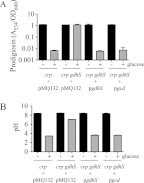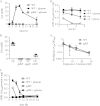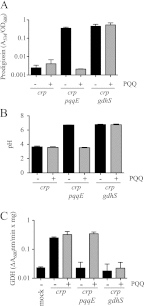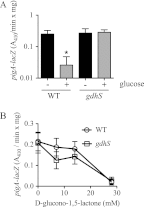Serratia marcescens quinoprotein glucose dehydrogenase activity mediates medium acidification and inhibition of prodigiosin production by glucose
- PMID: 22752173
- PMCID: PMC3416624
- DOI: 10.1128/AEM.01778-12
Serratia marcescens quinoprotein glucose dehydrogenase activity mediates medium acidification and inhibition of prodigiosin production by glucose
Abstract
Serratia marcescens is a model organism for the study of secondary metabolites. The biologically active pigment prodigiosin (2-methyl-3-pentyl-6-methoxyprodiginine), like many other secondary metabolites, is inhibited by growth in glucose-rich medium. Whereas previous studies indicated that this inhibitory effect was pH dependent and did not require cyclic AMP (cAMP), there is no information on the genes involved in mediating this phenomenon. Here we used transposon mutagenesis to identify genes involved in the inhibition of prodigiosin by glucose. Multiple genetic loci involved in quinoprotein glucose dehydrogenase (GDH) activity were found to be required for glucose inhibition of prodigiosin production, including pyrroloquinoline quinone and ubiquinone biosynthetic genes. Upon assessing whether the enzymatic products of GDH activity were involved in the inhibitory effect, we observed that d-glucono-1,5-lactone and d-gluconic acid, but not d-gluconate, were able to inhibit prodigiosin production. These data support a model in which the oxidation of d-glucose by quinoprotein GDH initiates a reduction in pH that inhibits prodigiosin production through transcriptional control of the prodigiosin biosynthetic operon, providing new insight into the genetic pathways that control prodigiosin production. Strains generated in this report may be useful in large-scale production of secondary metabolites.
Figures







Similar articles
-
Thermoregulation of Prodigiosin Biosynthesis by Serratia marcescens is Controlled at the Transcriptional Level and Requires HexS.Pol J Microbiol. 2019;68(1):43-50. doi: 10.21307/pjm-2019-005. Pol J Microbiol. 2019. PMID: 31050252 Free PMC article.
-
The LysR Transcription Factor, HexS, Is Required for Glucose Inhibition of Prodigiosin Production by Serratia marcescens.Adv Microbiol. 2012 Dec 1;2(4):10.4236/aim.2012.24065. doi: 10.4236/aim.2012.24065. Adv Microbiol. 2012. PMID: 24358451 Free PMC article.
-
Cyclic AMP negatively regulates prodigiosin production by Serratia marcescens.Res Microbiol. 2010 Mar;161(2):158-67. doi: 10.1016/j.resmic.2009.12.004. Epub 2010 Jan 4. Res Microbiol. 2010. PMID: 20045458 Free PMC article.
-
Recent advancements in high-level synthesis of the promising clinical drug, prodigiosin.Appl Microbiol Biotechnol. 2019 Feb;103(4):1667-1680. doi: 10.1007/s00253-018-09611-z. Epub 2019 Jan 12. Appl Microbiol Biotechnol. 2019. PMID: 30637495 Review.
-
High-level production of microbial prodigiosin: A review.J Basic Microbiol. 2021 Jun;61(6):506-523. doi: 10.1002/jobm.202100101. Epub 2021 May 5. J Basic Microbiol. 2021. PMID: 33955034 Review.
Cited by
-
Thermoregulation of Prodigiosin Biosynthesis by Serratia marcescens is Controlled at the Transcriptional Level and Requires HexS.Pol J Microbiol. 2019;68(1):43-50. doi: 10.21307/pjm-2019-005. Pol J Microbiol. 2019. PMID: 31050252 Free PMC article.
-
Crystal Structure and Function of PqqF Protein in the Pyrroloquinoline Quinone Biosynthetic Pathway.J Biol Chem. 2016 Jul 22;291(30):15575-87. doi: 10.1074/jbc.M115.711226. Epub 2016 May 26. J Biol Chem. 2016. PMID: 27231346 Free PMC article.
-
A Serratia marcescens PigP homolog controls prodigiosin biosynthesis, swarming motility and hemolysis and is regulated by cAMP-CRP and HexS.PLoS One. 2013;8(3):e57634. doi: 10.1371/journal.pone.0057634. Epub 2013 Mar 1. PLoS One. 2013. PMID: 23469212 Free PMC article.
-
Chromosomal barcodes for simultaneous tracking of near-isogenic bacterial strains in plant microbiota.Nat Microbiol. 2024 Apr;9(4):1117-1129. doi: 10.1038/s41564-024-01619-8. Epub 2024 Mar 19. Nat Microbiol. 2024. PMID: 38503974 Free PMC article.
-
Metagenomic analysis reveals that modern microbialites and polar microbial mats have similar taxonomic and functional potential.Front Microbiol. 2015 Sep 23;6:966. doi: 10.3389/fmicb.2015.00966. eCollection 2015. Front Microbiol. 2015. PMID: 26441900 Free PMC article.
References
-
- Anthony C. 2004. The quinoprotein dehydrogenases for methanol and glucose. Arch. Biochem. Biophys. 428: 2–9 - PubMed
-
- Ben Farhat M, et al. 2009. Characterization of the mineral phosphate solubilizing activity of Serratia marcescens CTM 50650 isolated from the phosphate mine of Gafsa. Arch. Microbiol. 191: 815–824 - PubMed
-
- Bouvet OM, Grimont PA. 1988. Extracellular oxidation of d-glucose by some members of the Enterobacteriaceae. Ann. Inst. Pasteur Microbiol. 139: 59–77 - PubMed
-
- Bunting MI, Robinow CF, Bunting H. 1949. Factors affecting the elaboration of pigment and polysaccharide by Serratia marcescens. J. Bacteriol. 58: 114 - PubMed
Publication types
MeSH terms
Substances
Grants and funding
LinkOut - more resources
Full Text Sources

